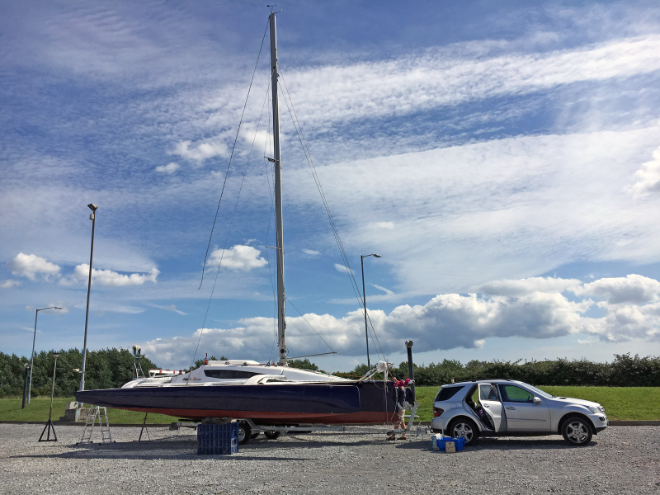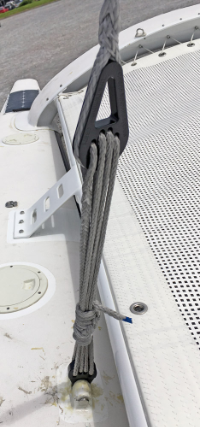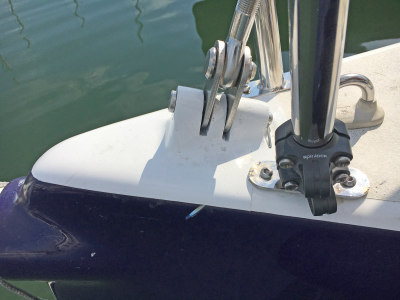Off to the Seaside!
Categories
Tags
Recent articles
Ubuntu 16.10 LXC host on ZFS Root, with EFI and Time Machine
How to connect any serial device to the internet


Last Sunday we finally moved the boat out of the shed, it's home for two years and three months. Of course this went smoothly.
Ha. Trying to lift a 14m long, 120kg mast 4 meters into the air is not as simple as it sounds with three people. Worse, three hours after we had planned to leave we had half the trailer jacked up, the axles loosened and were trying to align them using a sledgehammer and a chainblock for persuasion.
Do trailers have a personality? I hope so. Every day I tell it it's going to be melted down, in the hope I can instill in an inanimate object the same fear of impending death that it gave me.
 Driving through South London was actually fine, with light Sunday afternoon traffic.
But once on the M25 the limits became apparent - anything above 45mph (70km/h) the
wobble became
severe. We also had to stop once as the boat shifted on the trailer - the bow had
come off the narrow
roller at the front and the metalwork had gouged a chunk out of the bow. On the plus
side our
Merc ML320
was bought specifically because it's rated to tow over 3 tonnes, and it did it's job
well.
Driving through South London was actually fine, with light Sunday afternoon traffic.
But once on the M25 the limits became apparent - anything above 45mph (70km/h) the
wobble became
severe. We also had to stop once as the boat shifted on the trailer - the bow had
come off the narrow
roller at the front and the metalwork had gouged a chunk out of the bow. On the plus
side our
Merc ML320
was bought specifically because it's rated to tow over 3 tonnes, and it did it's job
well.
We pulled into Port Solent two and a half hours after leaving London, where only one more disaster awaited. The three of us were moving the outboard into the cabin for security, but apparently three plus an outboard at the very rear of the boat is too many. The boat tipped up and by the time I had jumped off and run to the front of the trailer it was one and a half meters in the air. It was actually quite nicely balanced, and I had to swing on it to bring the nose down with a thump. No-one was injured, the outboard was intact and we only had one more gouge on the boat, so we considered it a job well done and retired for the evening.
Mast up
The next day Paul Butler came up to give me a hand with the rigging. Paul built his F-32 "Wardance" from scratch, and it's still the only F-boat I have seen other than my own. We ordered shortly after visiting it, clearly Paul and his boat were very convincing.
I'm pretty clueless when it comes to rigging but it was actually pretty easy to do, and the first mast raise went off almost without a hitch. I'd mocked up a "mast" with PVC pipe while still in the shed, and had sized the mast raising wires based on that. Fortunately I was fairly accurate and everything went together well. The geometry has to be quite exact here, and the one problem we had was the mast raising wires were about 10mm too tight, resulting in an M6 bolt being pulled from it's backing plate and the destruction of a Saddle Eye. Wire doesn't stretch, which is why it's specified for the mast raising setup, but it does mean you need to check the tension constantly during the first raise. I forgot to do this, and am fabricating a new backing plate as a result.
We raised the mast with the trailer winch hooked to the Jib Halyard, and I was taking the slack on the Main Halyard with the winch as you can see in the video. The mast weighs 120kg and Ian has stated the load on the raising line peaks at about 320kg, which is well below the loads the halyard can take. However it still looks dubious, and once it was up it took a while before I was convinced it wasn't going to come crashing down again.
Standing Rigging
 The sidestays are 9mm Dynice Dux,
(called Dynex Dux until very recently). This stuff is absurd - these lines have a
breaking
strain of 7500kg - and is just a joy to work with compare to wire. A locking brummel
splice
is really the only option for terminating the lines, but it's very easy to do and
only reduces
the strength of the line by about 10%.
The sidestays are 9mm Dynice Dux,
(called Dynex Dux until very recently). This stuff is absurd - these lines have a
breaking
strain of 7500kg - and is just a joy to work with compare to wire. A locking brummel
splice
is really the only option for terminating the lines, but it's very easy to do and
only reduces
the strength of the line by about 10%.
Initially I didn't realise there are two ways to perform this splice. One version requires both ends to be loose, but you can splice the eye through an object, like a ring or a deadeye. The other version is marginally more complex and only requires one end of the rope to be free, but the splice cannot be done around anything (as the loop has be passed through the rope). Splice with a set of fids and some D-Splicer scissors, which are much quicker to use than a ceramic knife.
I'm using a deadeyes and chainplate distributers from Colligo, and the lashing process to take up tension is described in this PDF. It's a rotating mast so Paul advised there's no point in going nuts on the tension, which made it easier. However I have managed to get some other lines drum tight using this method.
The forestay is wire - I regret this decision, but it was made when I thought I might go for a roller-furling jib (which require wire). And this is where I cocked up. Ian's plans had a fork fitting connecting to the forestay chainplate, and I had a fork fitting on the wire. So I cut the slots in the chainplate for the fork. It wasn't until we came to assemble the forestay that I realised I had it upside-down - the fork fitting was the top of the forestay, the bottom was a different fitting. Oops.
The struture for the chainplate is built into the boat: what you can see is the tip of the iceberg, with a a large mesh of unidirectional carbon fibre spreading the load throughout the structure. So you only get one shot at cutting this. I emailed Ian and he suggested an approach which should work. I will update this page with pictures once it's done.
What next?
I've been the shed for two and a half years. When I'm not there I've been buying parts, designing the electronics, writing and testing the software, oh and attempting to run a business and see my long-suffering family occasionally. Frankly, I am done. I've handed her off to a local boat yard to clean up my mess - I seem to have got Epoxy everywhere - and in a few weeks we'll put her in the water and see if I sealed the thru-hulls properly.
Update 26 June 2016
 Ian's suggestion for the forestay fix worked at treat. I had two "link plates" lasercut
from 5mm
stainless to fit the slots I'd cut. I didn't work out the strength, but it's roughly
the same amount
of steel as used in the fitting at the top of the wire so should be OK. Cost, about
£30 from my
favourite lasercutting firm, and the forestay length is about
the same.
Ian's suggestion for the forestay fix worked at treat. I had two "link plates" lasercut
from 5mm
stainless to fit the slots I'd cut. I didn't work out the strength, but it's roughly
the same amount
of steel as used in the fitting at the top of the wire so should be OK. Cost, about
£30 from my
favourite lasercutting firm, and the forestay length is about
the same.
You can just see the U-bolt behind it - this is for the jib tack, which a far as I could see was left open in the plans. I suppose another option would have been to to attach it to the base of the forestay somehow, but this will do: it's a 10mm Wichard U-Bolt with matching backing plate, and the deck here is about an inch thick with lots of reinforcement. It should be strong enough.
